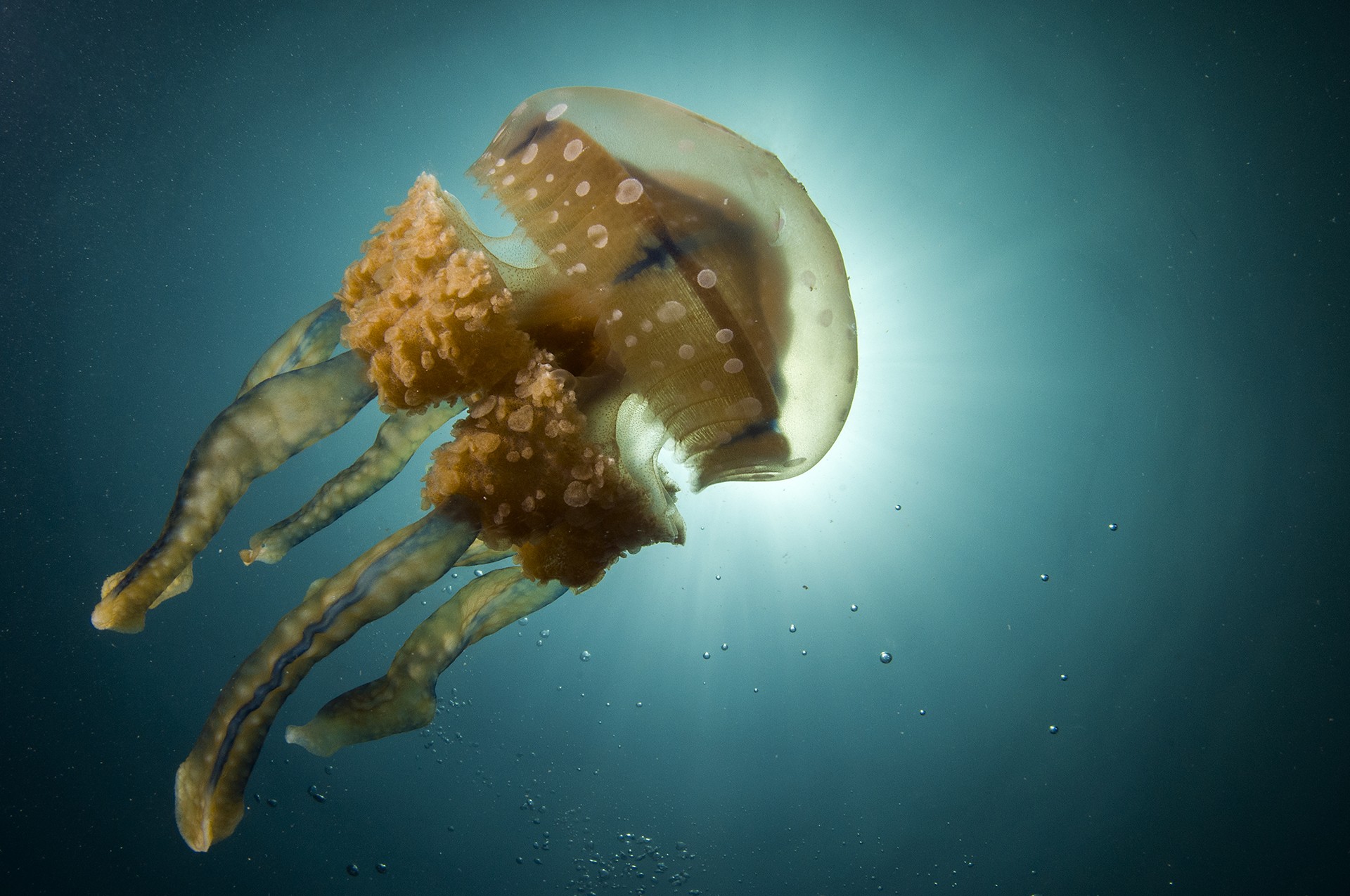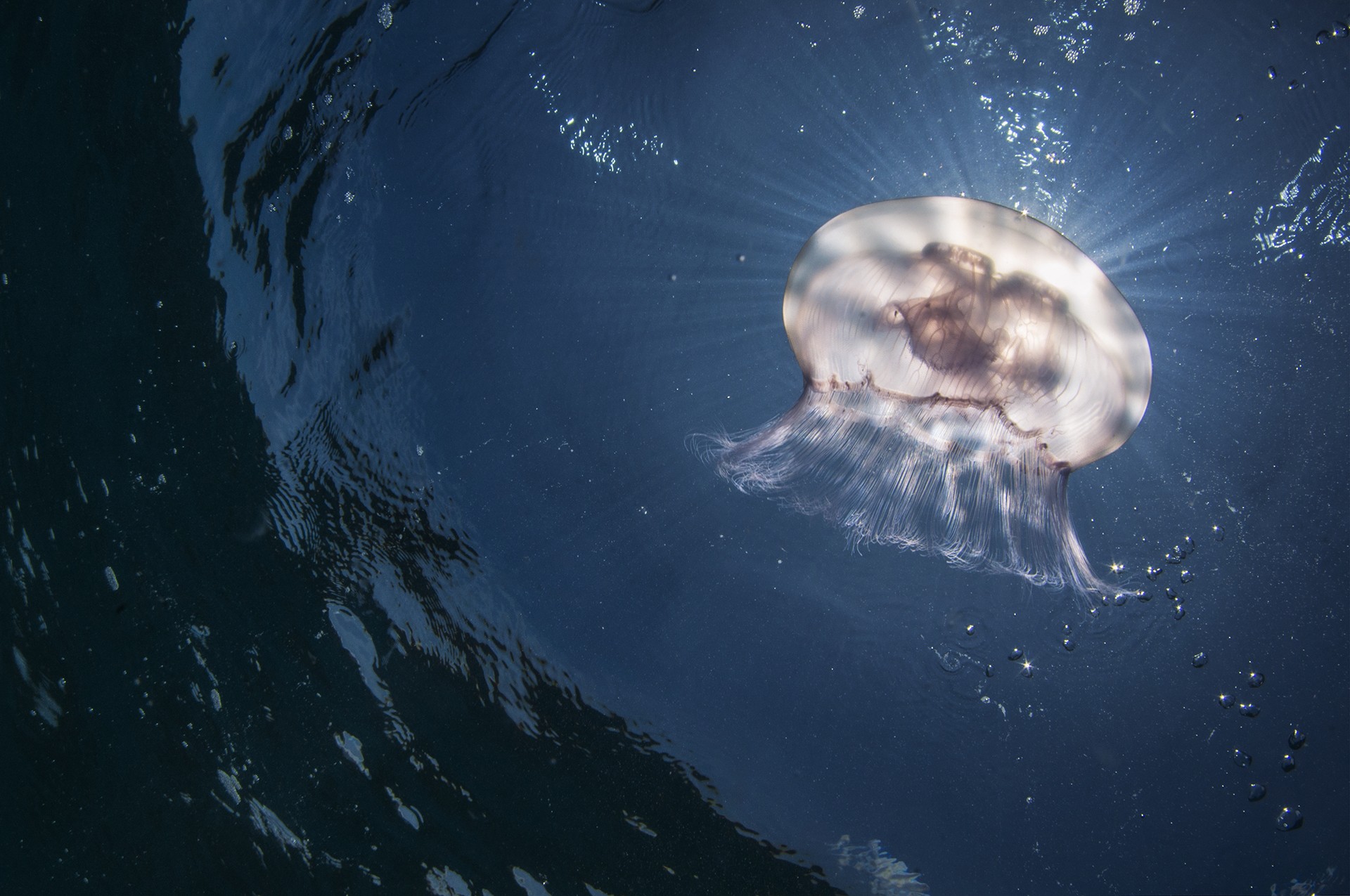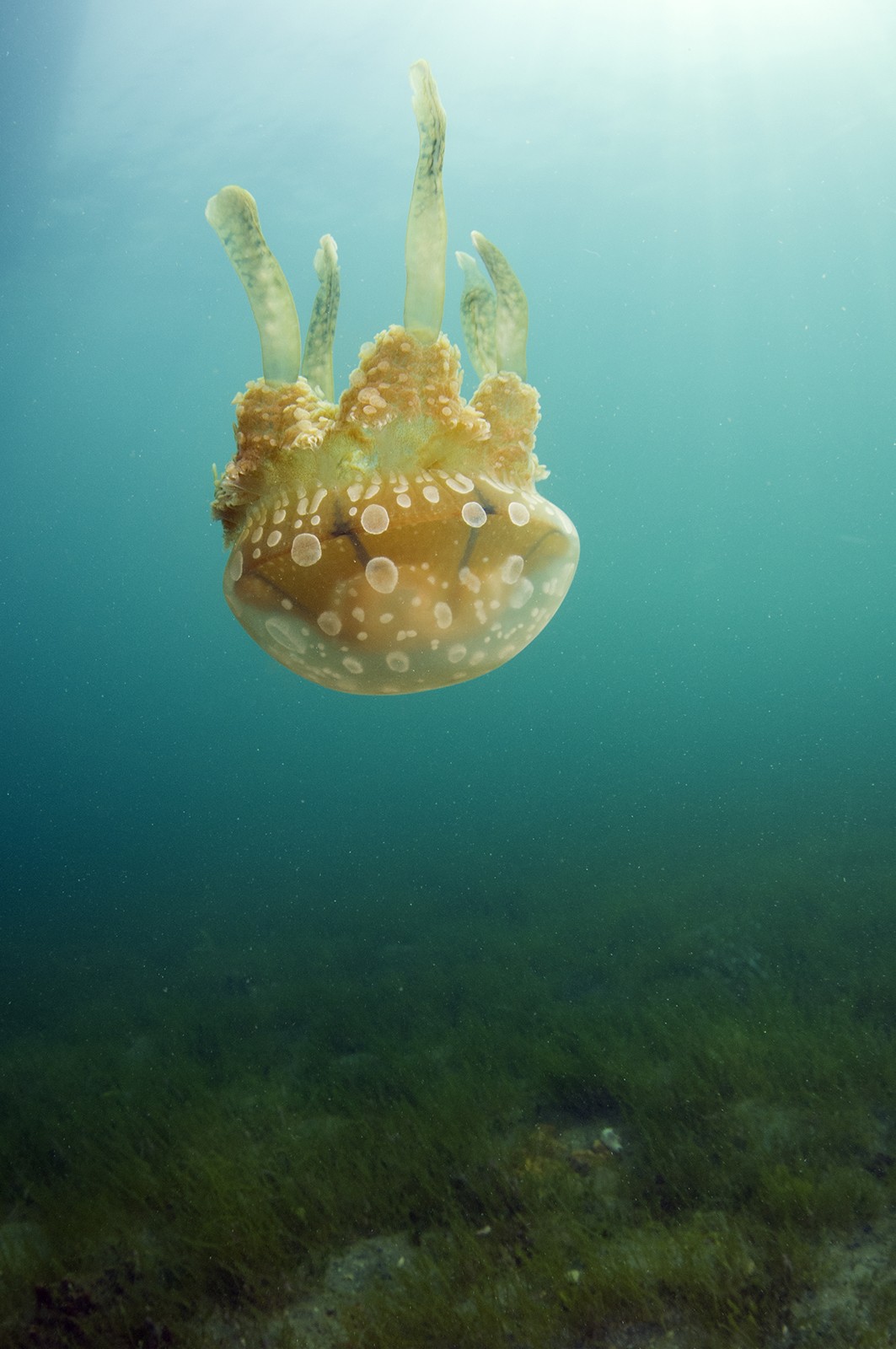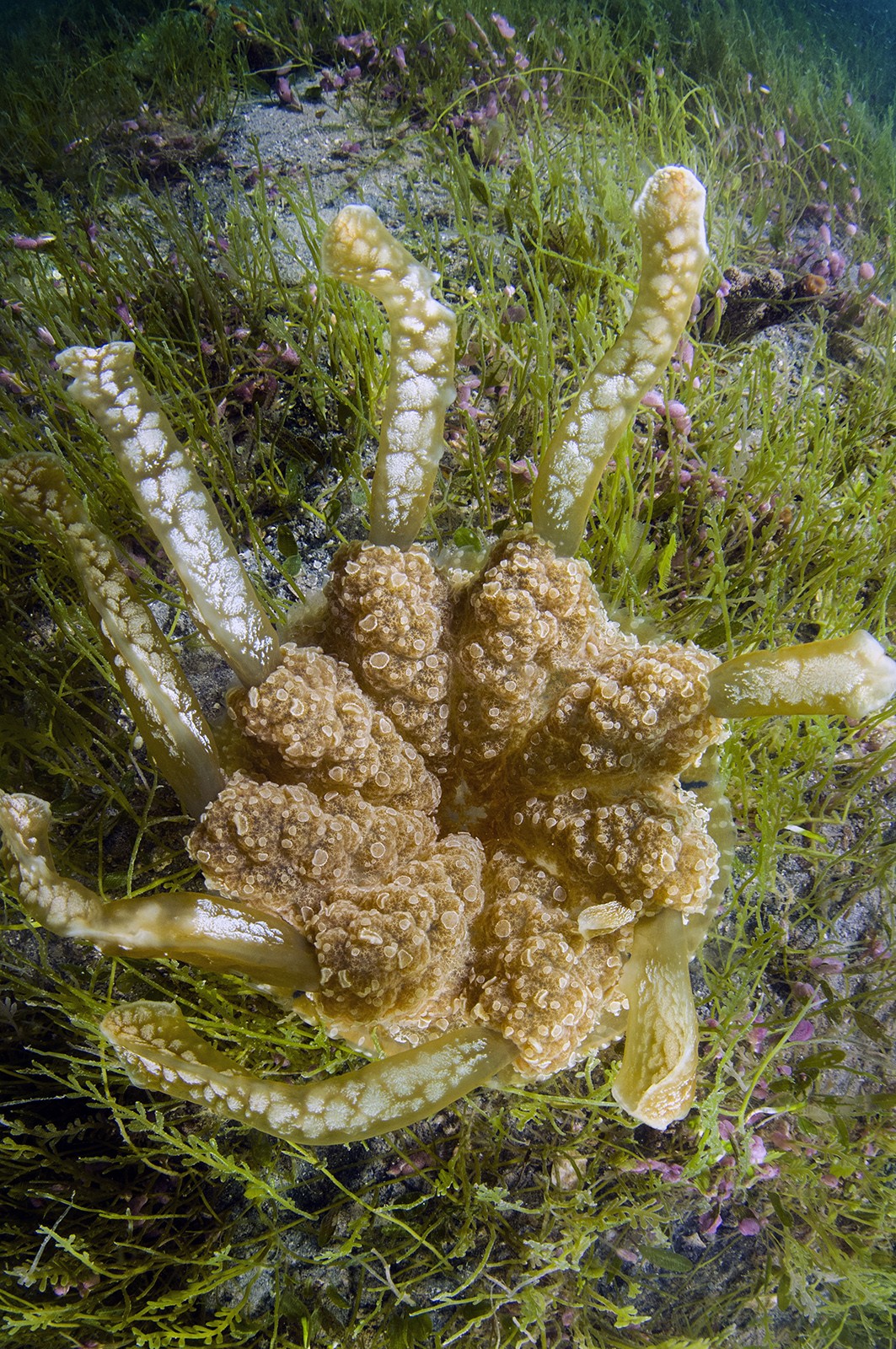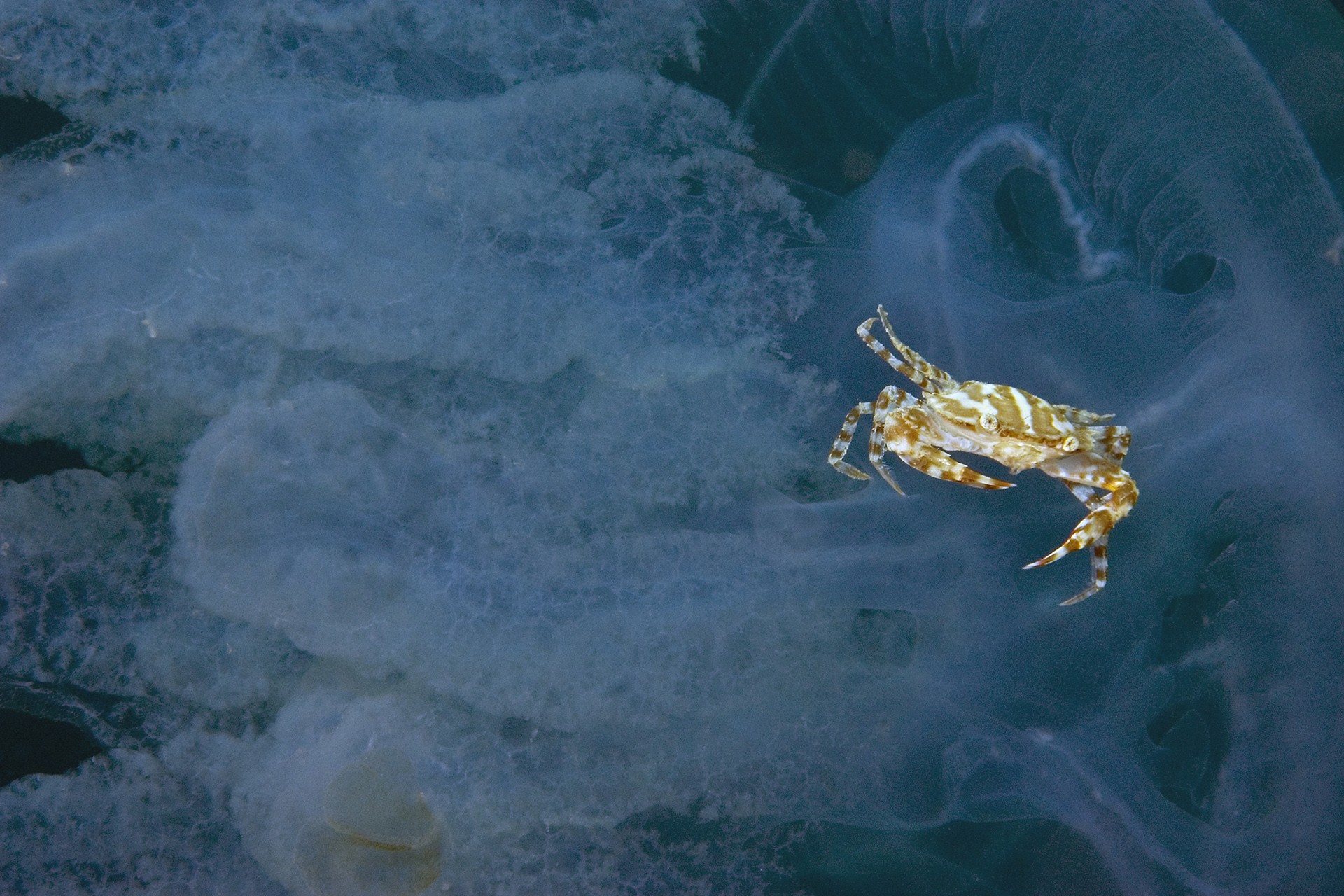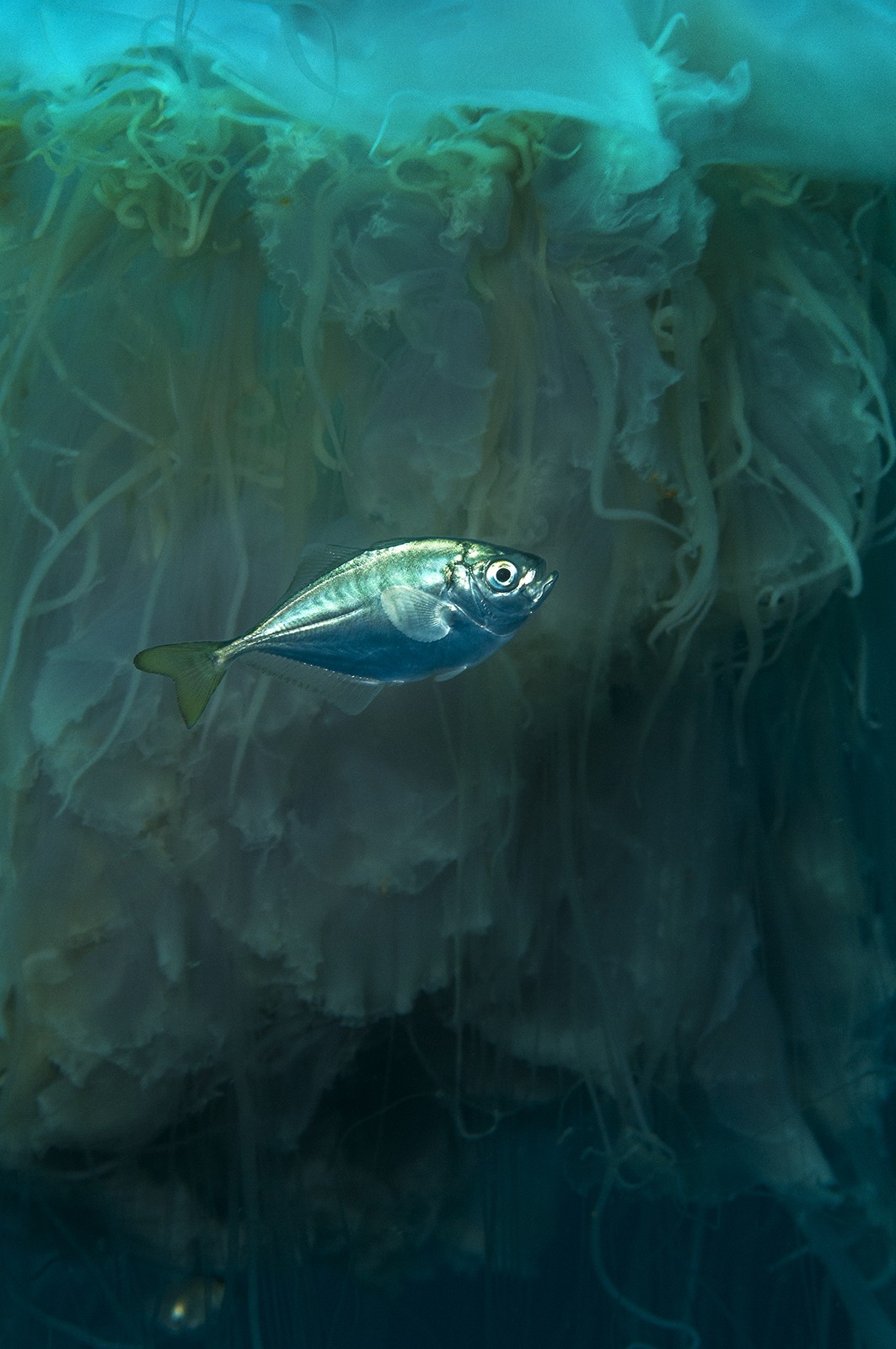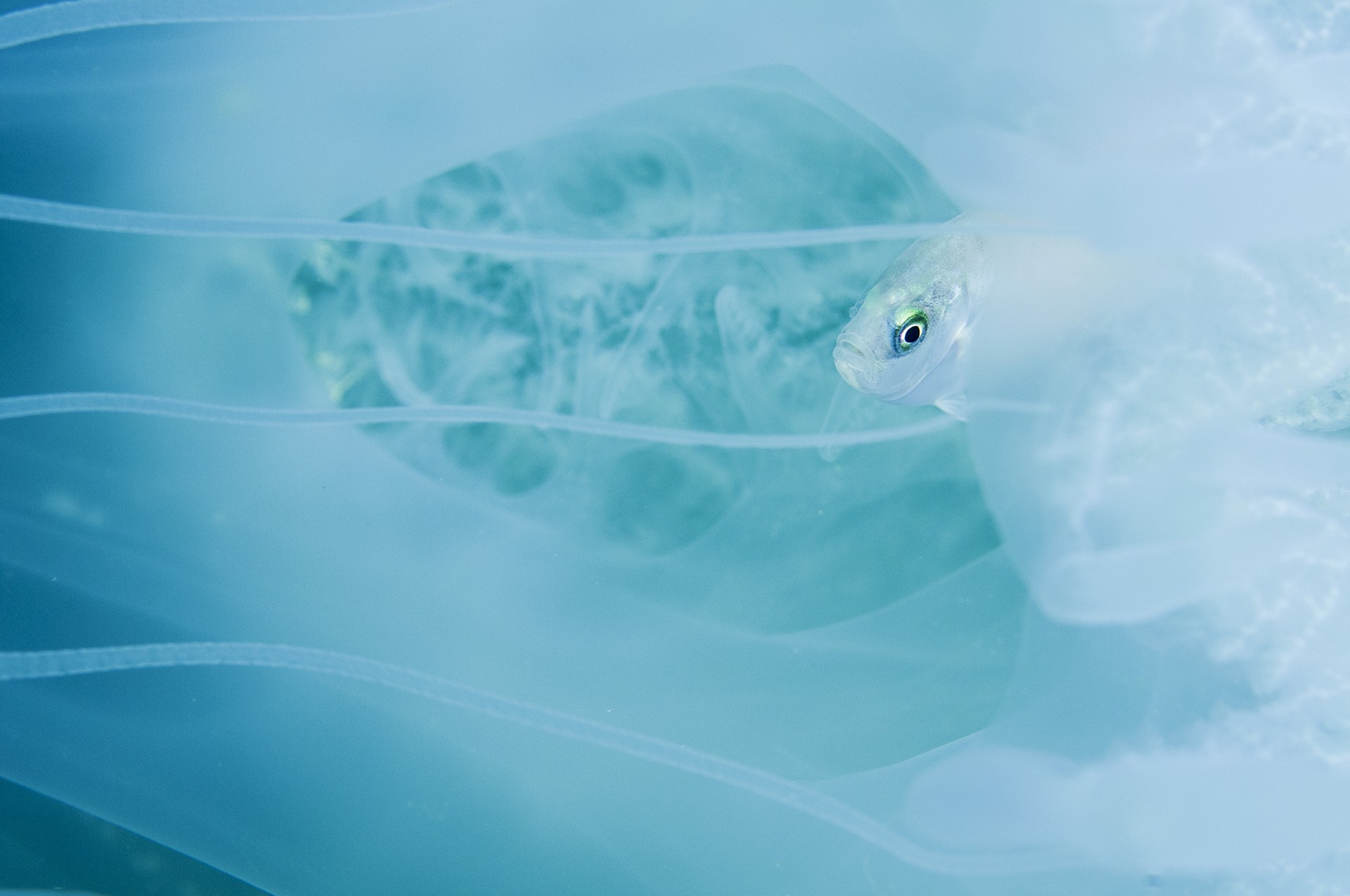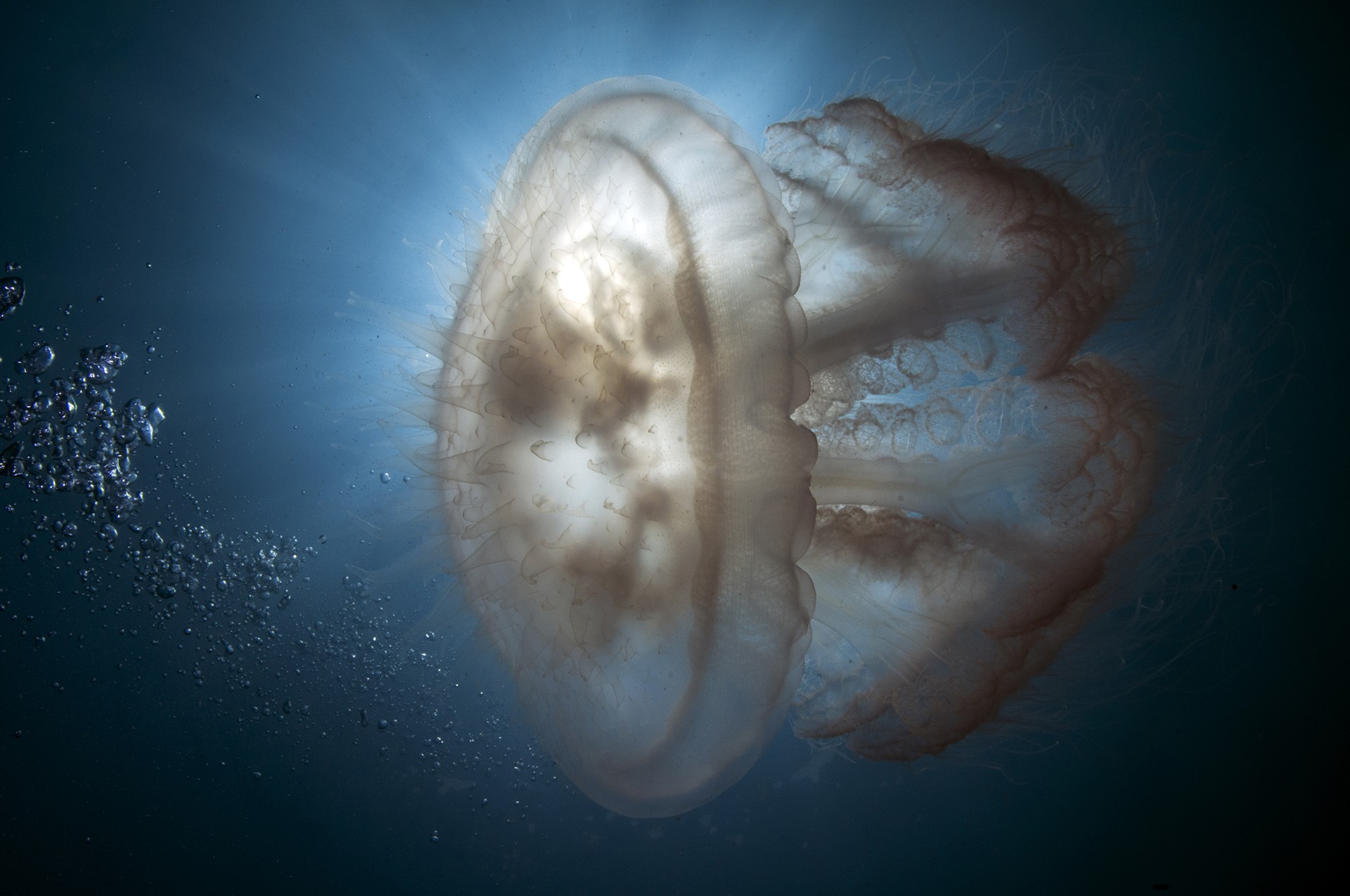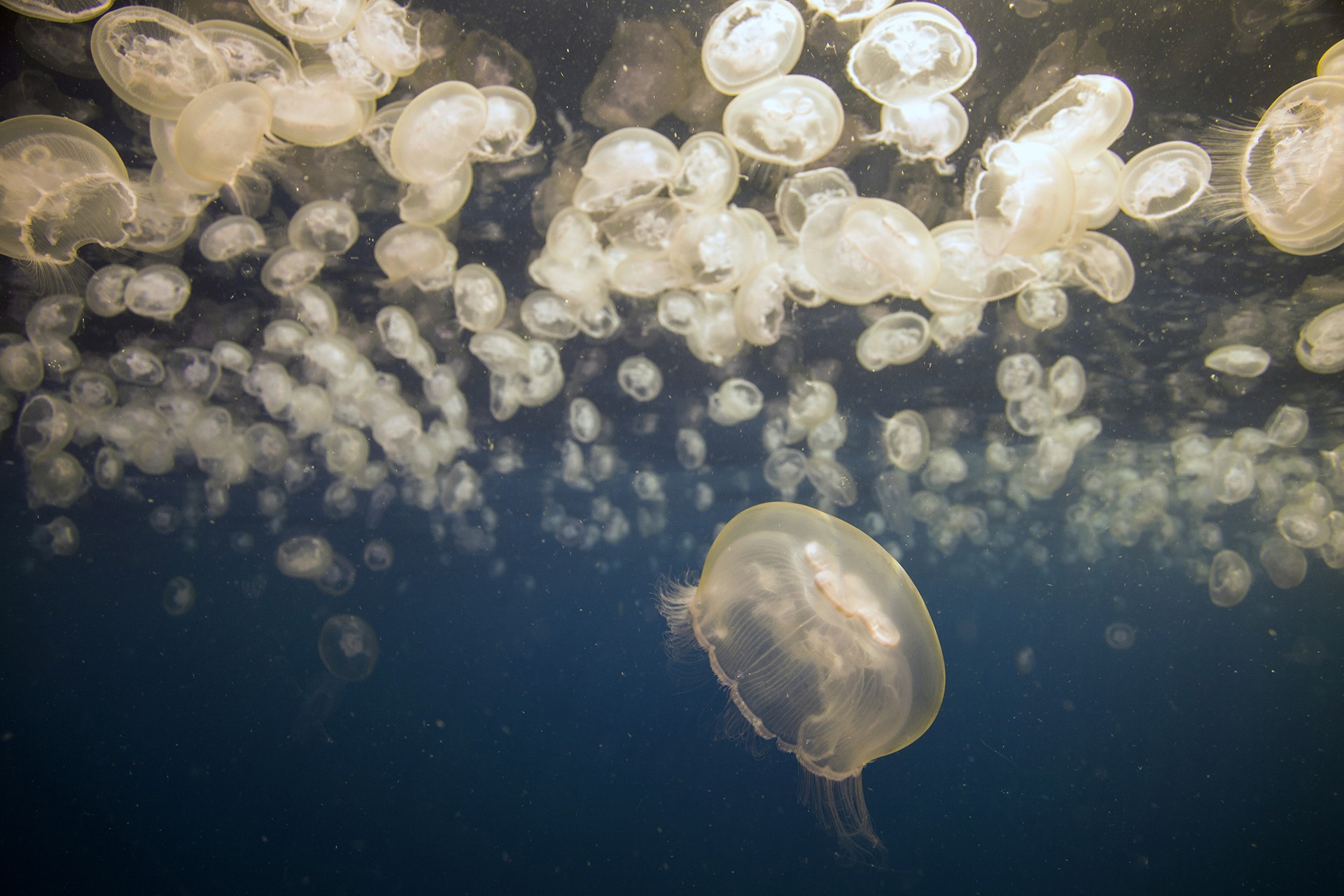The jellyfish I knew were not well behaved. In 2012, I spent a few months making observations on Copula sivickisi, a fingernail-sized box jellyfish found in Australian waters. I had put a dozen of them in a 1.5-metre-tall cylinder of Plexiglass to mimic their natural depth range. This particular species of Cubomedusae was known to be active at night, resting during the day on the seafloor. Every night, I would sit at the foot of the tank with my red flashlight (a wavelength they find harder to detect) and watch them move through the water, hoping that they would start doing the things I had convinced my Master’s thesis advisor they would do. But they did not.
Instead of sleeping in the daytime, they bobbed at the surface of the water with great enthusiasm. They got their thread-like tentacles all tangled up with other jellyfish tentacles in a worrying spool of gelatinous bits. Some nights, I would see a single male spend hours chasing females, dancing around them tirelessly, his tentacles trying to grab onto one of theirs. But other males seemed to actively avoid any company, swimming away quickly when another individual approached. And during the swim test I put them through – to see how fast they could swim – many of them did the opposite of swimming. They curled into a ball and attached themselves resolutely to the side of the tank. At the time, of course, this was very frustrating. I was sleep-deprived with a deadline and I was convinced that these animals were all conspiring against me.
In retrospect, however, I see the messiness differently. They did not all do the same thing, but why had I expected them to? Until then I had always assumed that jellyfish were straightforward animals, in the way that one would expect most invertebrates to be. In some ways perhaps, that is not untrue. But an increasing amount of research is showing that the way jellyfish sense and see and live in their world is nothing short of complex. More than a few times, I wondered how they saw me on the other side of the glass – after all, they did each have 24 eyes on their translucent bells. Box jellies also seemed to exhibit characteristics very different from other jellyfish I had seen and read about. How, and when, had these differences evolved?
If we shimmy down the tree of life to 550-odd million years ago, we see the oceans of the earth, newly oxygenated and warmer than before, radiate with bizarre life. On the seabed, scaly pineapple-shaped Wiwaxia burrow under microbial mats, and cactus-like Pirania sponges filter the water for food. Among these strange forms, an ancestor of the jellyfish possesses something that no other life form has until now – organised tissues, a nervous system, and the ability to use this to swim through the water in search of prey. Exactly when jellyfish appeared is still debated. And depending on the kind of evidence used (DNA or fossil) estimates vary between 700 to 550 million years ago. Nevertheless, at some point in this period, this ancestor of present-day jellyfish detached itself from the sea floor, where it had lived until then, to explore the waters above.
Most jellyfish have two broad stages in their lives. The one that is visible to us – so the one we know best – is the adult medusa. When they reproduce, most medusoid jellies release a cloud of sperm and eggs into the water, and fertilisation results in planulae (small, hairy, pear-shaped animals) that drift about for a while before they settle on the sea floor to become a polyp. This stalked polyp, flower-like but with a mouth and tentacles, may stay here for a while, eating and slowly growing, until it begins to strobilate, or bud mini-jellyfish into the water. Saucer-shaped baby jellies, known as ephyrae (all splayed arms instead of tentacles, small flattened bells instead of the translucent dome of a mature adult) eventually grow to become adult jellyfish. These are the medusae we commonly encounter in the water. When the ancestor of present-day jellyfish decided to leave the sea floor to roam in the ocean, it was only for a part of its life. Till today, several stages of a jellyfish’s life are spent mostly invisible from view, in a less-imagined form on the sea floor. (But some jellyfish do mix things up. Recently, a species made the news when scientists found adults capable of reverting to a polyp again. These jellyfish were pronounced “biologically immortal”; in times of stress, an adult was able to settle back on the sea floor, revert to the polyp stage, grow new cells, and start life over.)
While jellyfish might go through roughly similar stages in their lives, classes have evolved to be vastly different from each other. Cubozoans, or box jellyfish, use their sophisticated camera-type eyes to actively hunt for prey and can swim as fast as 1.3-2 m/second, close to the average speed humans walk at. My fastest swimming jellyfish reached a speed of 12 cm/second – impressive, I think, for an animal only a few cm in diameter. Some box jellyfish can navigate using objects on land, their eyes able to make out shapes even outside the water.
In contrast, scyphozoans, or “true” jellyfish mostly drift with currents and do not possess the visual machinery of cubozoans. Why? The simplest explanation is that the animal they both started off as long, long ago (i.e., their common ancestor) probably had a set of characteristics that were selected for, and evolved differently as these lineages diverged. Cubozoans might have evolved in circumstances slightly different from their scyphozoan cousins, where an ability to control swimming and good vision were rewarded and selected for. In scyphozoan habitats, this might not have been as important. Instead, other traits evolved, like the ability to house algae and use this to capture light. Like their more distant cousins – stony corals – some scyphozoans are almost half-plant, fulfilling much of their energy requirements through photosynthesis.
Both classes of jellyfish do, however, possess cnidocytes, stinging cells that are used to immobilise prey or defend against predators. But again, this trait took different paths as jellyfish diverged. While a sting from a box jellyfish can kill a person quickly, scyphozoan venom is not nearly as dangerous. In fact, some fish and crabs are so unaffected by scyphozoan stingers that they may even spend the first stages of their lives hiding out in jellyfish bells, sometimes even eating the food a jellyfish catches for itself. The umbrella of a jelly is a convenient shelter and fish seek it out for protection in an ocean full of hungry mouths. But because of their venom, it is not common to see these cross-species associations in cubozoans. Within species, however, box jellyfish can be surprisingly intimate – the individuals of C.sivickisi I was studying perform a “wedding dance” while courting, the male taking hold of a female’s tentacle and spinning her around in the water before finally depositing a spermatophore onto one of her tentacles.
How these differences between jellyfishes came to be and why some species evolved the traits they did are questions that continue to intrigue scientists – mysteries not made any easier by the fact that the fragile bodies of jellyfish have not preserved well in the fossil record. But having studied jellyfish and now corals, I continue to be amazed that such “simple” animals can have such strange and fascinating lives.
Sometime last year, coming up from a dive in the Andaman Islands, I found myself right in the middle of a bloom of pink moon jellies. The surface of the water pulsated with translucent bells and delicate tentacles. Trying to dodge this gelatinous patch and swim towards the boat, I spotted a single jellyfish removed from the rest, dropping silently through the water to the bottom of the reef. What impulse was it responding to, that the others weren’t? Had it detected a bunch of clumsy divers and decided to make a quick retreat? I watched it for a while and then it was gone, liquid body disappearing into blue water.
